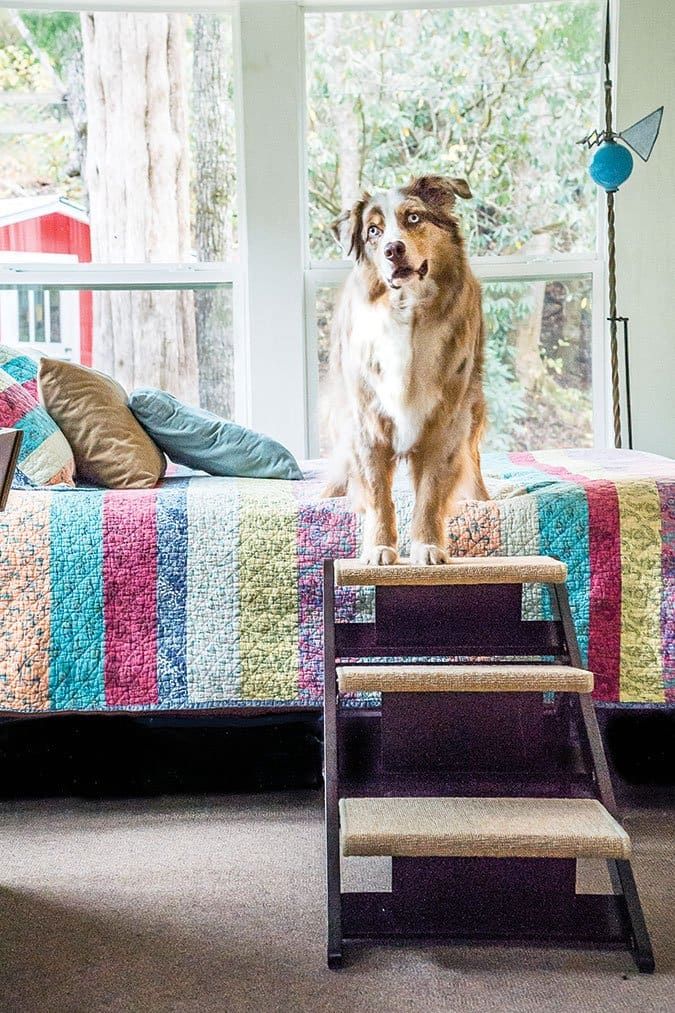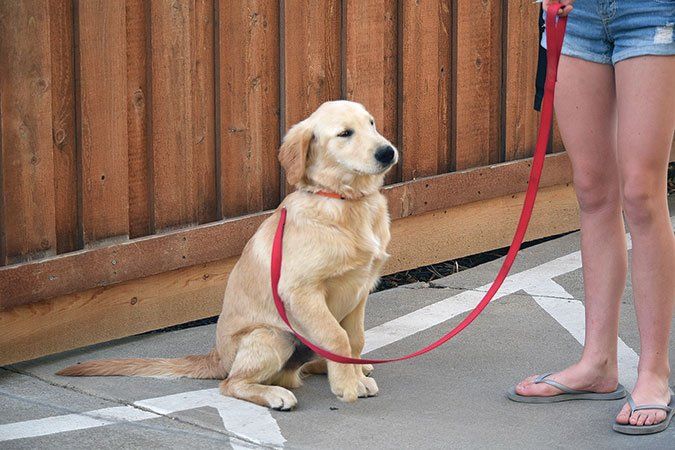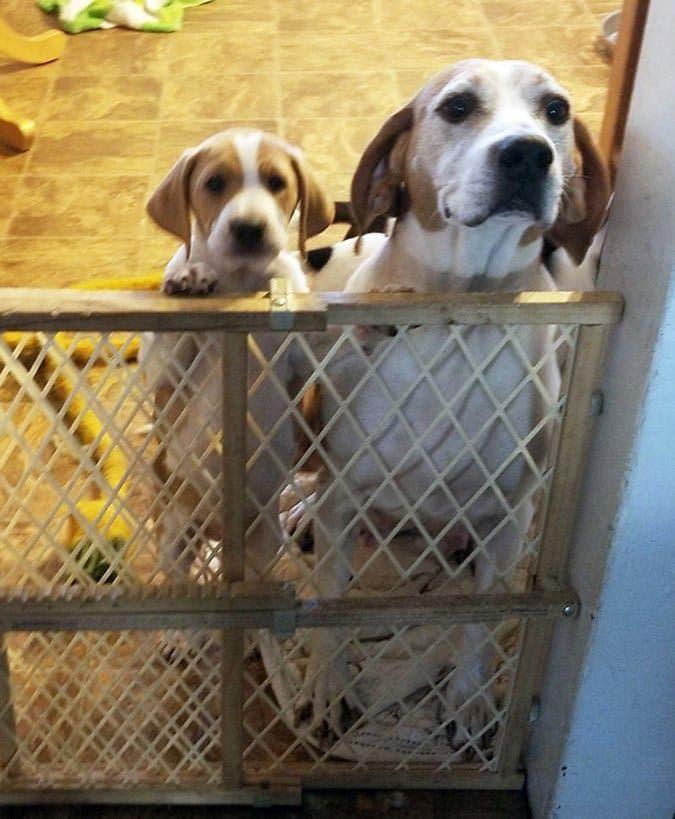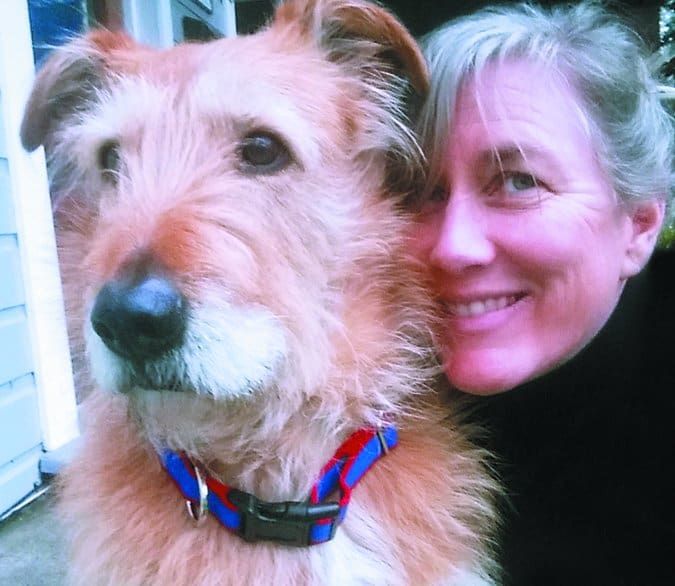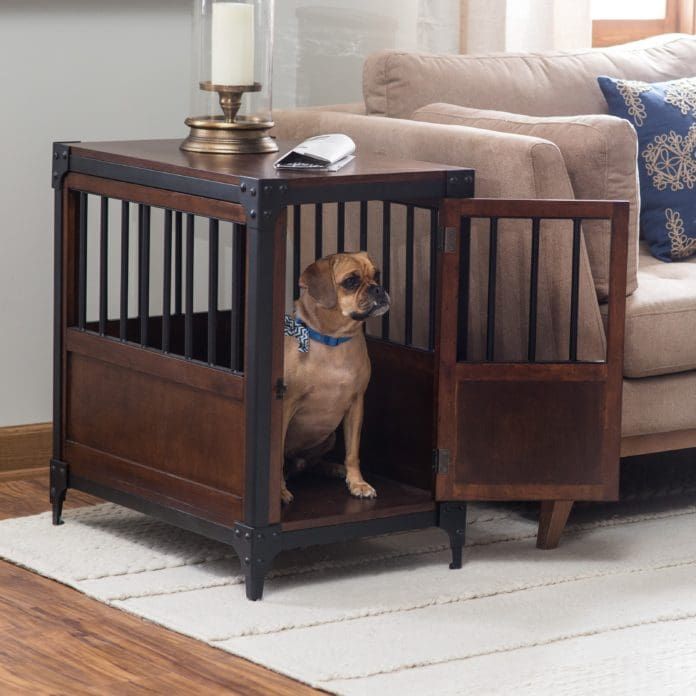I feel so fortunate to watch our Australian Shepherd Cody aging into a sensational senior dog. Cody developed serious health issues when he was only two years old. Because of autoimmune issues and now significant arthritis in his front elbows, at 11 years or so, he’s on a pain management regime prescribed by a veterinary specialist. Thankfully, he’s getting along quite well and most days seems to be mostly pain-free.
Recently, though, something happened that caused me to think he could benefit from the use of dog steps. Cody has always enjoyed sleeping on the bed in the guest room at night. Usually, when he first hears us stir, he hops down off the guest bed and jumps into bed with the rest of the family (two humans, another dog, and two cats – yes, a full bed!)
A couple of months ago, his behavior pattern changed. Instead of hearing his paws hit the floor, I heard soft whining. I went to see what was up and found him reticent to jump off the bed. Anyone who has had knee pain understands that stepping down is more painful than stepping up. True for Cody, too, so what to do but pick him up and put him on the floor.
Over the next few weeks there were days when he’d jump down quickly and join us in bed, and other days when he’d whine. Thankfully, I’m still able to lift his 48-pound body, though that repetitive movement over time probably isn’t good for my own body! I decided it was time to consider a set of dog steps that could make it more comfortable for him to move off the bed. Onward with the research!
Pet Stairs Compared
| Rating | Product | Price | Sizes | Weight/Weight Limit |

|
PET STUDIO RAMPSTEPS Available online from Overstock.com, Amazon.com, Chewy.com, Wayfair.com, and more. |
$190 to $207 (best price for us was from Amazon) | Two steps: 26″ L x 17 ½” W x 13″ H Three steps: |
Weighs: 12 lbs
Weight Limit: |
| Can be used as stairs or as a ramp with easy conversion from one to the other. Comes assembled, so time and frustration saving. Light enough to easily move. Folds flat for storage. | ||||

|
PETSFIT WOODEN PET STAIRS Manufacturer: petsfit.us Available from: Petsfit.us (two-step only), Amazon, Petsbeddepot.com |
$90 to $180 (best price for us was from Amazon) | Two steps: 22″ L x 17″ W x 14″ H Three steps: |
Weighs: Two steps: 17.6 lbs Three steps: 22.6 lbs Weight Limit: |
| Assembly is easier with two people. Side rails on the steps may be preferable for some dogs. Light enough to easily move. | ||||

|
PREMIER PET STEPS RAISED PANEL Manufacturer: Premier Pet Steps Available online from amazon.com, wayfair.com and petfrenzy.com |
Two steps: $88-$115 Three steps: $125-$167 Four steps: $187-$275 (best price for us was from Wayfair) |
Two steps: 15″ W x 12″ H x 16″ L Three steps: Four steps: |
Weighs: Two steps: 17 lbs Three steps: 27 lbs Four steps: 38 lbs Weight Limit: |
| All three sizes have options for solid tread (wood), non-slip tread or carpet. No assembly required. Made in the U.S. | ||||

|
SOLID SIDE PET STEPS for Large Dogs Manufacturer: Help Your Pets Available from: Help Your Pets |
Three steps: $160 Four steps: $200 |
Three steps: 24″ L x 17″ W x 19″ H Four steps: |
Weighs: Three steps: 35 lbs Four steps: 45 lbs Weight Limit: |
| No assembly required. Very durable and stable, though quite heavy to move. Fully carpeted, even sides and back. Seven carpet colors available. Non-stick pads available for an additional $15. Company offers wheels and handle if requested. Other models available for small dogs. Made in the U.S. | ||||

|
PET GEAR EASY STEP III, Extra Wide Manufacturer: Pet Gear, Inc. Available from Amazon.com, Chewy.com, Petco, Petsmart, Kohls, Wayfair.com, WalMart, Target |
$57 to $115 (best price for us was from Chewy) |
One step: 22″ W x 20″ H x 10″ L Two steps: Three steps: |
Weighs: One step: 10.5 lbs Two steps: 10 lbs Three steps: 14 lbs Weight Limit: |
| Nice wide steps, but rise on the first step difficult for two test dogs. Available in three sizes with removable and washable carpet tread. Rubber grippers on bottom to help secure the steps. Snaps together easily without tools. | ||||
Whole Dog Journal‘s Pet Step Rating Criteria
I weighed the following factors when trying to select pet stairs for Cody:
Height: Your criteria may be different than mine based on the size of your dog and the height of your bed. With a wide variety of dog steps available today, finding what you need is unlikely to be a problem. Based on the height of our bed, we needed steps that were in the range of 22 to 27 inches, which, for most manufactured steps, was a three- or four-step model.
Weight: It was important to have a set of steps that could easily be moved for cleaning, vacuuming, and ease in making the bed.
Safety: The steps needed to support a medium to large dog and have a non-slip surface that furry paws could easily negotiate. We also wanted rubber grippers or some other non-slip option on the bottom.
Aesthetics: Although beauty and luxury weren’t essential for me, I did want something that was reasonably attractive and fit with our relaxed, eclectic décor.
Ease of Assembly: I have to admit, I didn’t even think about putting the steps together, so assembly didn’t cross my mind. If that matters to you, I’ve included assembly information for each set of steps.
Cost: This wasn’t really a factor as I wanted the best product available and was willing to pay for it. Spare nothing for the dog! In my experience, bargain prices tend to mean low-quality manufacturing.
The Best (4-Paw) Pet Steps
The two sets of steps that rose to the top did so because all four test subjects (Cody and Willow, our two Australian Shepherds; Trixie, a Jack Russell Terrier; and Zak, a Beagle mix) were able to easily negotiate the steps. They were also light enough to easily move and were aesthetically pleasing.
Top Pick: PetStudio RampStairs

This was my favorite and also gets four paws up from Cody. The RampStairs (available in two and three steps) came fully assembled, so all I needed to do was pop them out of the box, raise the two front legs, and voila! They were ready to use.
The steps easily convert into a ramp, which could be preferable for some dogs. Cody preferred the steps, as he wasn’t easily able to negotiate the ramp and even slipped a little when coming down, although the Jack Russell moved up and down the ramp with ease.
I particularly liked the contemporary look of the RampStairs. The pine frame has a mahogany finish and steps are covered with a sand-colored, easy-to-clean carpet. The fact that the legs of the steps fold down and tuck under (handle and steps lock in place) make it easy to move and store them (they would easily fit under a bed).
#2 Pick: Petsfit Wooden Pet Stairs

The steps have solid sides, which means that when the dog goes up or down, he’s unable to see the drop-off on each side. Some dogs likely find this comforting – like having a railing on stairs for humans.
While the product literature says these are easy to assemble, having a second person on hand to help out was handy: one person to hold the parts together while the other turns the screws. All four of the dogs were able to easily negotiate this set of steps.
#3 Pick: Premier Pet Steps Raised Panel Three-Step Stairs

No assembly required for this set of stable and durable steps made of Appalachian Red Oak. Since this product is solid wood, it’s a bit heavier than our top two picks, though still quite easy to move around.
The company states that the finish is sealed well so that it’s scratch- and water-resistant, and that seemed accurate. You have the choice of a stain-resistant carpet or non-slip marine covering, though I don’t know what that material is made of. I was frustrated that there was no phone number listed on the company’s website and the contact form on the site didn’t work, so I couldn’t confirm the material.
These also come in two- and four-step options. All in all, this is a nice set of steps with a country-style look. Of our four test subject dogs, three negotiated the steps with relative ease.
Next Best Pet Stairs: 3-Paw Runners Up
I had minor issues with these products, but they may suit people and dogs with needs and taste different from mine just fine!
Solid Side Pet Steps for Large Dogs

The material used is half-inch cabinet-grade wood, and the steps are covered with olefin carpet (seven carpet colors available), which should wear well and clean easily.
Some dogs might feel more comfortable with the solid sides. The entire set is covered in carpet (except the bottom), so there’s no bare wood to get scratched, and the carpet would provide cushioning should you or your pet bump into it. Three of our four test dogs easily negotiated this set. Ignore the pet articles on the website, though, as the advice is badly outdated.
Pet Gear, Easy Step III, Extra Wide

I did love the light weight of these steps and was easily able to pick them up with one hand. Assembly was effortless, as the plastic parts snap together easily with no tools needed. The carpet tread is attached with Velcro, so it’s removable and washable, which is a nice feature. The Easy Step also comes in a one- and two-step option.
When Dogs Avoid Their Steps
After all this, interestingly, my search for steps to help Cody was, as yet, unsuccessful. While the Pet Studio RampStairs were his favorite (and mine), and he could negotiate them quite well, he still avoids any step option by either jumping over or beside them. My guess is that he prefers to jump off the bed once rather than amble down three or four steps because each step down causes pain.
When I discussed this with Cody’s veterinary pain specialist, Dr. Tami Shearer of Western Carolina Animal Pain Clinic in Sylva, North Carolina, she said, “In my opinion, jumping down results in repetitive or jarring injury to the forelimbs and cervical spine, so that’s where I see the most need for inclines or steps, for prevention. Most available steps are so short and steep and most ramps are too narrow, too short, and too steep for most larger dogs to comfortably use them.”
If you’re tempted to try steps for your senior dog, I suggest borrowing a set first. However, if you have a young dog who repetitively jumps in and out of a car or SUV, or on and off of a bed, then purchasing a set of steps and training your dog to use them is likely the best way to prevent forelimb problems later in life.
How to Train Your Dog to Negotiate Steps
If your dog has never negotiated any kind of steps, the mere sight of the new set of steps could cause a “What the heck is this thing?” response. Place the steps against a wall in the common living area of your home – somewhere your dog already enjoys spending time with you. You can play games with your dog near the steps, have a fun training session near the steps, let your dog enjoy a stuffed Kong beside them, and even feed meals from a bowl on or near the steps. Do this for a few days until your dog is fully comfortable being near and passing the steps.
I use a clicker as a marker signal, though you can also use a short word such as “Yes!” to mark the behavior, which will then be reinforced with a piece of food.
Place the steps where your dog will need to use them. Get some pea-sized pieces of yummy food that your dog really loves, such as baked chicken or cheese. I like to use a food the dog doesn’t get on a daily basis. Take a piece of food, put it at your dog’s nose and lure him to (not on) the first step, mark, and reinforce. Take another piece of food and toss it slightly away from the steps (you’re resetting the dog to return to the steps). Because you’re sitting or standing near the steps and you just fed him at the step, he’ll likely quickly return to you.
Next, slowly use the food lure (right at your dog’s nose) to lure his front paws up onto the first step. If even one of his paws touches the first step, mark and reinforce. Continue luring until you get both front paws up on the first step. Mark and reinforce. And be sure to praise your dog, too! I like to repeat this step several times until the dog is easily putting two paws up on that first step.
Now help your dog get his back paws up on the step. Dogs don’t always easily learn to use each back foot independently, so take your time. Go as slow as necessary for your dog to feel comfortable and safe.
Once he has two front paws on the first step, take another piece of food and very slowly begin to lure your dog to the second step. As his front paws move up and onto that second step, it will likely cause him to stretch to reach for the food (keep it right at his nose). When he picks up one hind foot, mark and reinforce. When he gets the second hind foot up on the second step, mark and reinforce. Continue slowly luring him up each successive step until he reaches the bed or sofa. Hooray! You’ve successfully tackled the “up”!
Going down can be more challenging for dogs. Again, move at your own dog’s pace. You’re going to repeat the same process of luring, marking, and reinforcing your dog for successful negotiation of each step.
If he bypasses the steps by jumping down and around them, no worries. Just lure him back up the steps, then begin again to lure him down. If you move at his pace, your efforts will likely be met with success. If he bypasses the steps several times in a row, end the training session and start again several hours later or even the next day. Each dog gains confidence at a different pace and there’s no need to rush the process.
For more help training your senior dog to use the pet stairs, read “Training an Older Dog,” by Pat Miller, CBCC-KA, CPDT-KA.
Lisa Lyle Waggoner is a CPDT-KA, a CSAT (Certified Separation Anxiety Trainer), a Pat Miller Certified Trainer Level 2, faculty for the Victoria Stilwell Academy of Dog Training and Behavior, a dog*tec Certified Professional Dog Walker, and the founder of Cold Nose College in Murphy, North Carolina.


